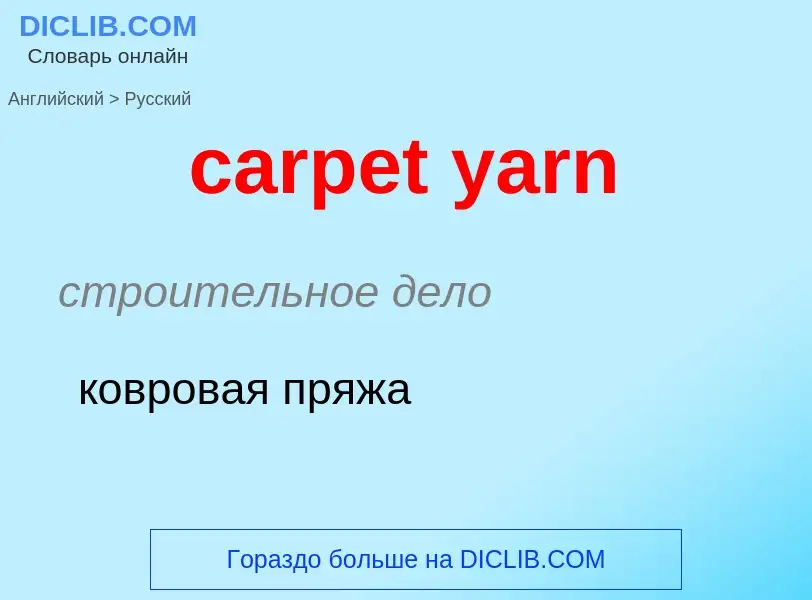Перевод и анализ слов искусственным интеллектом ChatGPT
На этой странице Вы можете получить подробный анализ слова или словосочетания, произведенный с помощью лучшей на сегодняшний день технологии искусственного интеллекта:
- как употребляется слово
- частота употребления
- используется оно чаще в устной или письменной речи
- варианты перевода слова
- примеры употребления (несколько фраз с переводом)
- этимология
carpet yarn - перевод на русский
строительное дело
ковровая пряжа
['kɑ:pit]
общая лексика
площадь
покрытая густой однородной растительностью
ковер
энтомология
пяденица
строительное дело
ковровое покрытие (пола), ковёр
(асфальтовый) слой износа (наносимый на существующее дорожное покрытие)
чистый дощатый пол (устраиваемый поверх чёрного дощатого пола)
существительное
['kɑ:pit]
общая лексика
ковёр
специальный термин
покрытие
одежда (дороги)
воровской термин
три месяца тюрьмы
церковное выражение
покров
пелена (напрестольная)
глагол
общая лексика
устилать
покрывать коврами
устилать (цветами и т. п.)
дорожное дело
покрывать тонким слоем (битума и т. п.)
разговорное выражение
вызывать и делать выговор
замечание
дать нагоняй
Определение
Reference to how boring carpet shopping is, or how monotonous and lacking in personality a person is.
I don't believe how carpet this speaker is - I bet he practices carpetry.
Википедия

A carpet is a textile floor covering typically consisting of an upper layer of pile attached to a backing. The pile was traditionally made from wool, but since the 20th century synthetic fibers such as polypropylene, nylon, or polyester have often been used, as these fibers are less expensive than wool. The pile usually consists of twisted tufts that are typically heat-treated to maintain their structure. The term carpet is often used in a similar context to the term rug, but rugs are typically considered to be smaller than a room and not attached to the floor.
Carpets are used for a variety of purposes, including insulating a person's feet from a cold tile or concrete floor, making a room more comfortable as a place to sit on the floor (e.g., when playing with children or as a prayer rug), reducing sound from walking (particularly in apartment buildings), and adding decoration or color to a room. Carpets can be made in any color by using differently dyed fibers. Carpets can have many different types of patterns and motifs used to decorate the surface. Carpets are used in industrial and commercial establishments such as retail stores and hotels and in private homes. Today, a huge range of carpets and rugs are available at many price and quality levels, ranging from inexpensive, synthetic carpets that are mass-produced in factories and used in commercial buildings to costly hand-knotted wool rugs that are used in private residences.
Carpets can be produced on a loom quite similarly to woven fabric, made using needle felts, knotted by hand (in oriental rugs), made with their pile injected into a backing material (called tufting), flatwoven, made by hooking wool or cotton through the meshes of a sturdy fabric, or embroidered. Carpet is commonly made in widths of 12 feet (3.7 m) and 15 feet (4.6 m) in the US and 4 m (13 ft) and 5 m (16 ft) in Europe. Since the 19th and 20th century, where necessary for wall-to-wall carpet, different widths of carpet can be seamed together with a seaming iron and seam tape (formerly it was sewn together) and fixed to a floor over a cushioned underlay (pad) using nails, tack strips (known in the UK as gripper rods), adhesives, or occasionally decorative metal stair rods. Wall-to-wall carpet is distinguished from rugs or mats, which are loose-laid floor coverings, as wall-to-wall carpet is fixed to the floor and covers a much larger area.


![Alcaraz rug]] at the [[Nazmiyal collection]] Alcaraz rug]] at the [[Nazmiyal collection]]](https://commons.wikimedia.org/wiki/Special:FilePath/16th-Century-Antique-Alcaraz-Rug-Nazmiyal-Carpet-Gallery-NYC.jpg?width=200)

![A carpet seller in [[Jaipur]], India A carpet seller in [[Jaipur]], India](https://commons.wikimedia.org/wiki/Special:FilePath/A carpet seller in Jaipur.jpg?width=200)
![[[Oushak]] (Usak) carpet (late 19th century) [[Oushak]] (Usak) carpet (late 19th century)](https://commons.wikimedia.org/wiki/Special:FilePath/AntiqueUsakCarpetLate19thCentury.jpg?width=200)
![One of the [[Ardabil Carpet]]s One of the [[Ardabil Carpet]]s](https://commons.wikimedia.org/wiki/Special:FilePath/Ardabil Carpet.jpg?width=200)
![Berber-style carpet]]. Berber-style carpets feature two sizes of tufts of varying colors in a loop pile construction Berber-style carpet]]. Berber-style carpets feature two sizes of tufts of varying colors in a loop pile construction](https://commons.wikimedia.org/wiki/Special:FilePath/Berber Carpet (macro).jpg?width=200)
![A traditional rug being woven on a carpet [[loom]] A traditional rug being woven on a carpet [[loom]]](https://commons.wikimedia.org/wiki/Special:FilePath/Carpet in Preparation on a Carpet Loom.jpg?width=200)
![Carpet with geometric patterns on the floor in kindergarten. [[Buryatia]], [[Russia]] Carpet with geometric patterns on the floor in kindergarten. [[Buryatia]], [[Russia]]](https://commons.wikimedia.org/wiki/Special:FilePath/Carpet with geometric patterns on the floor in kindergarten. Buryatia, Russia.jpg?width=200)
![''The Carpet Seller'' ([[Giulio Rosati]]) ''The Carpet Seller'' ([[Giulio Rosati]])](https://commons.wikimedia.org/wiki/Special:FilePath/Giulio Rosati 14.jpg?width=200)

![[[Kayseri]] prayer rug from [[Anatolia]], Turkey [[Kayseri]] prayer rug from [[Anatolia]], Turkey](https://commons.wikimedia.org/wiki/Special:FilePath/Kayseri prayer rug, Anatolia Turkey.jpg?width=200)
![Modern carpet illustrating a camel caravan on the [[Silk Road]] Modern carpet illustrating a camel caravan on the [[Silk Road]]](https://commons.wikimedia.org/wiki/Special:FilePath/Moden carpet illustrating camel caravan on Silk Road. Kashgar.jpg?width=200)
![Ourika Valley, Morocco]] Ourika Valley, Morocco]]](https://commons.wikimedia.org/wiki/Special:FilePath/OurikaValleyCarpets.jpg?width=200)

![Fighting Group of the Working Class]] Fighting Group of the Working Class]]](https://commons.wikimedia.org/wiki/Special:FilePath/Staatliches Ehrengeschenk - DDR - Wandteppich - 20 Jahre Kampfgruppe der Arbeiterklasse.jpg?width=200)
![stamp]] featuring a carpet stamp]] featuring a carpet](https://commons.wikimedia.org/wiki/Special:FilePath/Stamp of Moldova 138.jpg?width=200)
![tufted]] carpet tufted]] carpet](https://commons.wikimedia.org/wiki/Special:FilePath/Swatches of carpet 1.jpg?width=200)
![The [[Czartoryski]] carpet with coat of arms of the Polish Myszkowski family,<ref name=polish /> made with a [[cotton]] warp, a [[silk]] weft and pile, and metal wrapped thread (Iran, 17th century) The [[Czartoryski]] carpet with coat of arms of the Polish Myszkowski family,<ref name=polish /> made with a [[cotton]] warp, a [[silk]] weft and pile, and metal wrapped thread (Iran, 17th century)](https://commons.wikimedia.org/wiki/Special:FilePath/The Czartoryski Carpet.jpg?width=200)

![An 18th century [[Savonnerie]] tapisserie at the [[Palace of Versailles]] An 18th century [[Savonnerie]] tapisserie at the [[Palace of Versailles]]](https://commons.wikimedia.org/wiki/Special:FilePath/Savonnerie tapisserie 18th century Versailles.jpg?width=200)

![A mythical [[magic carpet]] A mythical [[magic carpet]]](https://commons.wikimedia.org/wiki/Special:FilePath/Vasnetsov samolet.jpg?width=200)
![''The Carpet Seller'', a [[Royal Doulton]] figurine ''The Carpet Seller'', a [[Royal Doulton]] figurine](https://commons.wikimedia.org/wiki/Special:FilePath/The_Carpet_Seller,_a_figurine_by_Royal_Doulton.jpg?width=200)
